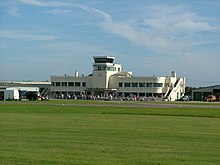RAF Shoreham
|
Shoreham Airport Brighton City Airport |
|||||||||||||||||||||||
|---|---|---|---|---|---|---|---|---|---|---|---|---|---|---|---|---|---|---|---|---|---|---|---|
 |
|||||||||||||||||||||||
| Summary | |||||||||||||||||||||||
| Airport type | Public | ||||||||||||||||||||||
| Operator | Brighton City Airport Ltd | ||||||||||||||||||||||
| Serves | South of West Sussex | ||||||||||||||||||||||
| Location | Lancing, West Sussex | ||||||||||||||||||||||
| Elevation AMSL | 7 ft / 2 m | ||||||||||||||||||||||
| Coordinates | 50°50′08″N 000°17′50″W / 50.83556°N 0.29722°WCoordinates: 50°50′08″N 000°17′50″W / 50.83556°N 0.29722°W | ||||||||||||||||||||||
| Website | www.flybrighton.com | ||||||||||||||||||||||
| Map | |||||||||||||||||||||||
| Location in West Sussex | |||||||||||||||||||||||
| Runways | |||||||||||||||||||||||
|
|||||||||||||||||||||||
| Statistics (2014) | |||||||||||||||||||||||
|
|||||||||||||||||||||||
| Passengers | 452 |
|---|---|
| Movements | 54,344 |
Shoreham Airport (IATA: ESH, ICAO: EGKA), also known as Shoreham (Brighton City) Airport or simply Brighton City Airport, is an airport located in the parish of Lancing near Shoreham-by-Sea in West Sussex, England. It has a CAA Public Use Aerodrome Licence that allows flights for the public transport of passengers or for flying instruction.
Founded in 1910, Shoreham is the oldest airport in the UK and the oldest purpose-built commercial airport in the world. It is now owned by Brighton City Airport Ltd (BCAL). The 1930s Art Deco terminal building is listed.
The airport is 1 NM (1.9 km; 1.2 mi) west of Shoreham-by-Sea at Lancing in the Adur district of West Sussex. It is situated immediately to the south of the A27 road, between Brighton and Worthing, and immediately to the north of the West Coastway railway line.
The first aviator to fly there was Harold Piffard in 1910; a memorial garden celebrates his flight. The aerodrome was officially opened on 20 June 1911. The first flying school opened in 1913.
During the First World War the aerodrome was used by the Royal Flying Corps. It was the departure point for some of the earlier flights (Blériots and BEs) to join the conflict across the Channel.
The aerodrome became an airport for the adjacent towns of Brighton, Hove and Worthing in the 1930s. A new terminal building was opened on 13 June 1936. It was designed by Stavers Tiltman in the Art Deco style. The terminal building is still in use and was designated a Grade II* listed building in 1984.
...
Wikipedia

